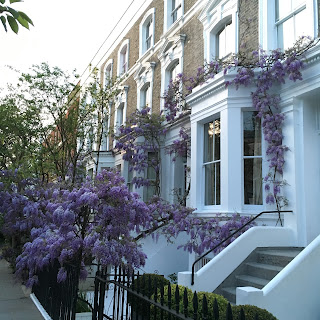Wandering around London on a sunny may day is one of my very
favorite things. I haven’t lived there in
years, but I feel like I've only been away on vacation. The hustle, the bustle, the cozy pubs and the
warming teas, it's all still here. Add to that, the mind blowing street
displays of an occasional flowering Wisteria.
When they bloom they spare no expense at advertising their
seduction.
The flowers, from a distance look like clusters of violet and purple grapes. They spend their long dormant winters clinging to a number of beautiful row houses. Their leafless bodies twist and have an almost exaggerated appearance of struggle. But they are only pretending. When the April showers are followed by sun rays in May, they wakesup. The haggard old vine throws on the heavy coat of cabaret makeup and comes out for another spectacular show.
The flowers, from a distance look like clusters of violet and purple grapes. They spend their long dormant winters clinging to a number of beautiful row houses. Their leafless bodies twist and have an almost exaggerated appearance of struggle. But they are only pretending. When the April showers are followed by sun rays in May, they wakesup. The haggard old vine throws on the heavy coat of cabaret makeup and comes out for another spectacular show.
Seasoned
veterans of the gardens, these ladies were first introduced to the English in
the early 19th century and have been a hit ever since.
There are 2 main types of cultivated Wisteria- Chinese (wisteria
sinesis) and Japanese (wisteria floribunda). The Chinese has many more flower
clusters reaching 12” and the Japanese has fewer, but longer clusters (up to 24”). An interesting fact I learned while reading
up on these magical vines is in their stem rotation(s). A big part of their strained appearance is
the twisting of the trunk and branches.




